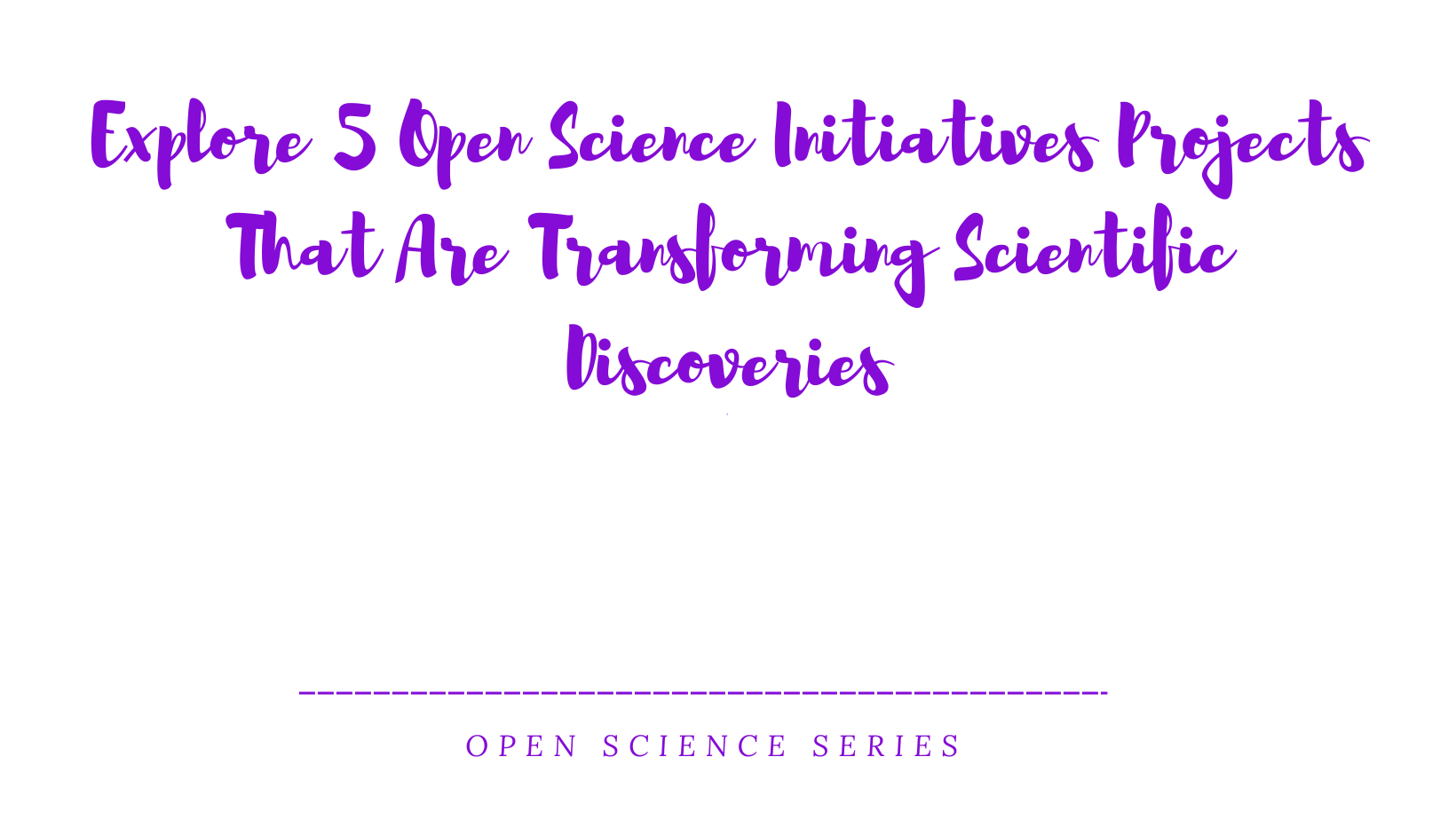Explore 5 Open Science Initiative Projects That Are Transforming Scientific Discoveries
 Zainab Ikeoluwa
Zainab Ikeoluwa
INTRODUCTION
Open source projects are ways scientists improve the tools and software they use in computational scientific research. In recent times, scientific researchers have had to depend on open-source tools to further their discoveries and, at times, have had to develop their tools in the lab for the specific purpose it is needed. Coming along those lines could be required tools for genomic analysis, molecular visualization, and so much more.
In my last article, I explained different Open Science Initiatives with respective examples. I'd be taking us through Open Science Initiatives projects in this article. These projects are categorized under the Open Data Initiatives and the Open-Source Software.
This article is for researchers with a coding background and developers with domain expertise in science. The science varies from biological knowledge to microbes.
Frantz Kati defines an Open-Source project as publicly available tools to use, change and share. Sometimes, in sciences, these projects are not tools. They go as far as models, literature, datasets, etc.
In no particular order, let's dive in;
OPEN DATA INITIATIVE
AYA Multilingual Project
The Cohere For AI started the Aya project to facilitate multilingual AI progress. According to Cohere, some languages receive more attention and focus in Natural Language Processes (NLP) than others. These local languages widen the gap in language access.
A recent update shows that Access to languages made Google Bard available in over 40 languages. Not only is Bard available to English speakers but other local dialects. Google's approach with Bard is an inclusive initiative, which the AYA project wants to achieve with its Multilingual generative model.
You do not necessarily need to be an AI expert or developer to contribute to the AYA project. You can fit into the community as a lifelong learner and love your language. If you want to contribute to language access through the AYA project, head to the AYA website to familiarize yourself with the community and start contributing.
Therapeutic Data Common
Therapeutics Data Common (TDC) is an Open Science Initiative in therapeutic sciences. They are a community of drug and biologics discovery. TDC resources cover an entire therapeutics development pipeline from discovery to optimization.
TDC is best suited for researchers and scientists at the intersection of drug discovery and Artificial Intelligence. TDC resources support model evaluation, data processing, and molecule generation.
Getting started with TDC is easy. Their dataset is available for personal projects with appropriate citations. However, contributing to TDC is more attractive as they are open to ML scientists and domain experts.
As a domain expert, coming across an exciting dataset in your benchwork is an added advantage to scientific research. ML researchers are ever ready to make a mountain out of your mole. If you like what you see, head over to tdcommons.ai.
OPEN-SOURCE SOFTWARE
National Resource for Network Biology (NRNB)
NRNB is a biologically based open-source project at the intersection of biology, computing, and network analysis. Understanding the biological system is a function of the connection between molecules in our body. It is also critical to understand the state of health and disease.
The NRNB project comprises different bioinformatics tools for molecular data analysis, cancer data analysis, molecular image visualization, and biological network query.
Contributors to NRNB tools range from people with software engineering skills and little biology background, biological science background with no coding skills, and none of the above. Explore different NRNB tools and head to the outreach page to join the community and get started if this interests you.
Ersilia Open Source Initiative
Ersilia Project is at the intersection of Artificial intelligence, Global health, infectious disease, and drug discovery. This project is interesting because they have a hub of ML and DL models that facilitates drug discovery research. They make the implementation of these models easy through their Ersilia platform.
Ersilia project aims to decrease the cost of laboratory experiments, leverage publicly available data and make data science and machine tools available to researchers and clinicians at tiny to no effort of use.
The Ersilia Model hub is the project's powerhouse, housing over a hundred models for predictive research. Contribution to Ersilia takes different forms. I have contributed to Ersilia on two occasions, and trust me; you'd learn a lot. Look at Ersilia Docs to learn more.
Avogadro
Avogadro is a molecular rendering software application. Avogadro is used to view and edit molecular structures in real-time. Chemical structures can be modified, manipulated, and optimized. This project is at the intersection of chemistry and computing.
Avogadro has an enabling community for new contributors. If you want to get involved, they seek contributors to help with code, documentation, translation, tutorial edits, lesson curation, and bug fixes. Look at contributing guidelines to learn more.
WHY SHOULD YOU CONTRIBUTE TO THIS PROJECT?
Contributing to open source and open science initiatives sure has a lot of benefits. Here are significant ones;
- Building your portfolio
- Improving your career prospect
- Improving the project
- Developing relationship
- Gaining valuable knowledge
I'd also like to note that, as a prospective graduate student, contributing to these specific projects boosts your confidence and helps you solidify your applications. As an active contributor, you get recognized for your work which can earn you a recommendation letter from an Open-Source project maintainer, a massive plus to your application. Additionally, on lucky occasions, you come across prospective supervisors in an Open-Source project. These and more are why you should get started.
Contributing to these projects takes different forms. You can access these kinds of projects through applications to programs such as;
- Outreachy
- Google Summer of Code
- Google Season of docs
- Project Community
My best approach is the Project Community. Joining the community is not program bound and limiting like applying through the different open source programs. This approach gives Access to the project team, maintainers, and fellow contributors.
SUMMARY
To contribute to open source, you can be someone other than an expert software engineer or a senior developer. Every little skill and domain knowledge you have is impactful if you can find a project that suits you and you are enthusiastic. As I have listed above, contributing to open source has a thousand and one benefits, and it is time to reap them.
You can use the following resources to start your Open-Source contribution.
- Open source The Complete Guide in 2023 - Frantz Kati
- The Technical Writers Guide to Contributing to Open Source Projects - Didicodes
- How to Contribute to Open Source Projects – A Beginner's Guide - Hillary Nyakundi
- Open Science Tools and Platforms: A Deep Dive at Open Science Initiatives - Zainab Ikeoluwa
Thank you for reading 👌
Subscribe to my newsletter
Read articles from Zainab Ikeoluwa directly inside your inbox. Subscribe to the newsletter, and don't miss out.
Written by

Zainab Ikeoluwa
Zainab Ikeoluwa
Hi, Nice to meet you 😊 Just a little something to leave you with; “You don’t start out writing good stuff. You start writing crap and thinking it’s good stuff, and then gradually; you get better at it. ” ―Octavia E. Butler.